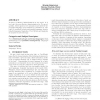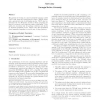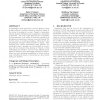ICFP
2006
ACM
14 years 11 months ago
2006
ACM
Design patterns are reusable abstractions in object-oriented software. However, using current mainstream programming languages, these elements can only be expressed extra-linguist...
ICFP
2006
ACM
14 years 11 months ago
2006
ACM
We describe an s-expression based syntax-extension framework much like Scheme macros, with a key additional facility: the ability to define static semantics, such as type systems ...
ICFP
2008
ACM
14 years 11 months ago
2008
ACM
We have implemented a two-stage language, Paradise, for building reusable components which are used to price financial products. Paradise is embedded in Haskell and makes heavy us...
PODS
2008
ACM
14 years 11 months ago
2008
ACM
A survey of effective characterizations of tree logics. If L is a logic, then an effective characterization for L is an algorithm, which inputs a tree automaton and replies if the...
POPL
2003
ACM
14 years 12 months ago
2003
ACM
We present the design of a typed assembly language called TALT that supports heterogeneous tuples, disjoint sums, and a general account of addressing modes. TALT also implements t...
102
click to vote
POPL
2005
ACM
14 years 12 months ago
2005
ACM
In traditional information-flow type systems, the security policy is often formalized as noninterference properties. However, noninterference alone is too strong to express securi...
POPL
2005
ACM
14 years 12 months ago
2005
ACM
A lightweight logical approach to race-free sharing of heap storage between concurrent threads is described, based on the notion of permission to access. Transfer of permission be...
POPL
2005
ACM
14 years 12 months ago
2005
ACM
Spatial logics have been used to describe properties of treelike structures (Ambient Logic) and in a Hoare style to reason about dynamic updates of heap-like structures (Separatio...
POPL
2006
ACM
14 years 12 months ago
2006
ACM
In PLT Scheme, programs consist of modules with contracts. The latter describe the inputs and outputs of functions and objects via predicates. A run-time system enforces these pre...
POPL
2006
ACM
14 years 12 months ago
2006
ACM
This article presents a polymorphic modal type system and its principal type inference algorithm that conservatively extend ML by all of Lisp's staging constructs (the quasi-...



